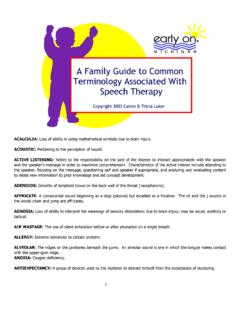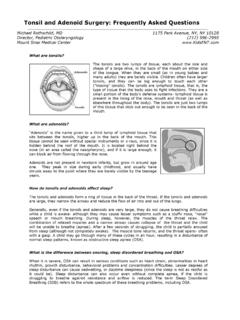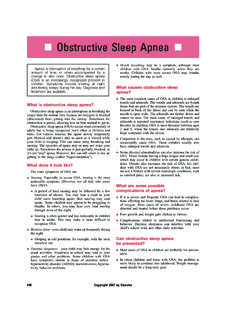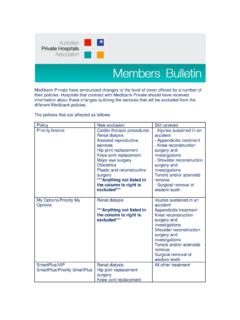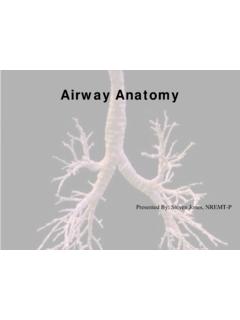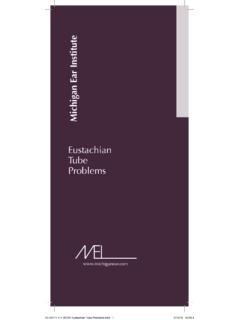Transcription of Nasopharyngoscopy - Nose & Sinus Clinic, PLLC
1 Vinod K. Anand, MD, FACS Nose and Sinus Clinic WHAT IS Nasopharyngoscopy ? Nasopharyngoscopy is a procedure which enables the doctor to examine the internal surfaces of the nose and throat (nasopharynx). The instrument used, called a flexible fiberoptic nasopharyngoscope, is equipped with a thin tube fitted with an eyepiece, lenses, and its own light source to illuminate the field of vision. The examination is carried out by the ENT specialist and takes a few minutes. It may be performed in the doctor's office or in the hospital special procedures room. If a biopsy (tissue sample) is required, Nasopharyngoscopy is usually performed in a daycare facility. A local anesthetic is sometimes used, and children may be given a sedative. WHY IS IT PERFORMED?
2 Nasopharyngoscopy provides a direct view of every part of the upper respiratory tract from the nasal passages down the throat to the larynx (vocal cords). It is an invaluable part of the investigation of many conditions from hoarseness and sore throat to lumps in the neck, nose bleeds, and snoring. The doctor may be looking for the cause of obstruction in the nasal airway of infants or adults. Abnormal growths (polyps, benign and malignant tumors) can be viewed and, where appropriate, biopsies (tissue samples) obtained for laboratory analysis. Nasopharyngoscopy can be used to observe a patient's progress after surgery or to monitor the effectiveness of antibiotic therapy. The Eustachian tube (which leads to the middle ear) opens at the back of the nose, and visible inflammation of the surrounding tissues is associated with middle ear infection.
3 Particularly in children, sleep apnea (temporary arrest of breathing while asleep) may be caused by an abnormal structure in the nose or by swollen tonsils or adenoids. Nasopharyngoscopy is also used by surgeons before a repair operation to assess a cleft palate (a defect in the roof of the mouth). RISKS AND BENEFITS Nasopharyngoscopy enables the doctor to view all of the upper respiratory tract. More accurate than X-ray imaging, it eliminates the need for repeated irradiation. A wide range of conditions can be assessed with very little risk to the patient. Laceration, bleeding, respiratory collapse and vomiting are the very rare complications. THE PROCEDURE PREPARING FOR Nasopharyngoscopy No special preparation is required for Nasopharyngoscopy .
4 In order to protect your clothes you may be asked to undress to the waist and put on a gown. For the examination, you will be seated upright in a tilting chair with your head supported. The nasal passage may be numbed with a local anesthetic spray, and an anesthetic lozenge or spray to the back of the throat Nasopharyngoscopy given to suppress the gag reflex. If a biopsy is going to be taken, or the patient is a child, the nose may be packed for a few minutes with cotton saturated with anesthetic solution. IN THE EXAMINING ROOM When the anesthetic has taken effect, the doctor stands in front of you, holding the eyepiece in one hand. With the other hand, he or she gently guides the tip along the floor of the nostril. You will be encouraged to breathe through your nose.
5 As the tip is advanced the doctor makes careful observations. Both nasal airways are visible from the back of the nose. The scope is then directed down the throat as far as the larynx. You may be asked to speak so that the doctor can watch the movement of the vocal cords. Observation continues as the scope is slowly withdrawn. AFTER THE PROCEDURE The examination is at an end when the nasopharyngoscope is removed. You will be helped out of the chair and should sit quietly for a while. If your throat has been anesthetized, it will take a few hours for the effects to wear off, and you must not eat or drink anything until sensation has returned fully. 1993. American Academy of Otolaryngology-Head and Neck Surgery, Inc.
6 This leaflet is published as a public service. The material may be freely used so long as attribution is given to the American Academy of Otolaryngology- Head and Neck Surgery, Inc., Alexandria, VA.
